Przewalski's horse
The Przewalski horse (Equus przewalskii), also called Tachi, Asian wild horse or Mongolian wild horse, is a species of the horse genus. It is named after the Russian expeditionary traveler Nikolai Mikhailovich Przewalski, who in 1878 brought back to St. Petersburg from one of his expeditions to Central Asia the skin and skull of this horse species, which was largely unknown in the Western world. It was scientifically introduced three years later. As special characteristics of the animals the compact physique, the relatively dark coat colouring, the standing mane and the formation of long hairs only in the lower half of the tail can be mentioned. In addition, an eel streak and occasionally a leg streak often appear.
At the time of its scientific naming, the Przewalski horse was already very rare. Shortly after the end of the Second World War there were only about 30 individuals in human care, only in the Prague Zoo and in the Hellabrunn Zoo in Munich foals of the species were still born. The last free-living specimen was sighted in 1969. Through dedicated breeding programs, however, the survival of the Przewalski's horse could be secured until today, the number increased again to about 2000 individuals. Coordination of breeding was improved by the establishment of a studbook in 1959. It is kept by the Prague Zoo, the EEP studbook is maintained by the Cologne Zoo.
Several initiatives are trying to re-establish the Przewalski's horse in the wild, and as a result the species can be found again in a few nature reserves in Mongolia. In addition, there are individual reserves scattered around the world with semi-wild populations. The animals are herd-forming and occur in family groups, which are led by a stallion and consist of mares and their foals. There are also pure bachelor groups. They roam large action areas in open landscapes. Their diet consists mainly of grasses. Feeding takes up a large part of the daytime, mostly taking place in the morning and evening. The offspring are born mainly in spring and are intensively cared for. In its entire behavioral repertoire, the Przewalski's horse shows strong similarities to the domestic horse.
According to genetic and anatomical findings, both forms, the Przewalski horse and the domestic horse, are closely related to each other. Partly, the Przewalski's horse was therefore also considered as a subspecies of the domestic horse or the "wild horse". From a taxonomic point of view, it is now often classified as an independent species, which is also supported by various characteristics. Generally, the Przewalski's horse was considered to be the last surviving representative of the Eurasian wild horses and their most eastern variety. However, a genetic study in 2018 showed that they are most likely feral descendants of a group of horses domesticated around 5500 years ago.
Features
Habitus
The external appearance of the Przewalski's horse can be set out according to original descriptions of hunted individuals and the births of the first generation of imported wild-caught animals of the beginning of the 20th century. According to these descriptions, the Przewalski's horse has a head-torso length of 220 to 280 cm - to which must be added a tail 99 to 110 cm long (with hair; without hair: 38 to 60 cm) - and a height at the withers between 134 and 146 cm. The weight varies from 200 to 300 kg. Stallions, with a height at withers of 138 to 146 cm, are slightly larger than mares, which measure 134 to 140 cm. In terms of weight, stallions weigh between 260 and 297 kg, mares between 244 and 280 kg. The animals correspond with it in its body-mass to a small until middle house-horse (Equus caballus). The physique gives a stocky impression due to the broad torso. The neck is short and thick, the withers do not rise prominently. The back forms a straight line, the croup is gently rounded and not split. The legs appear comparatively short and strong. The head appears large in proportion to the body, especially compared to the height at the shoulder, and is boxy elongated. In profile the forehead line is straight to slightly arched, the underside is straight. The rostrum is short and high. As a result, the upper and lower profile lines meet at an angle of 16° to 18°30' in the Przewalski horse (up to 21° in young animals). In contrast to the domestic horse, the angle is thus more sharply defined, in the latter it is 25° to 32°. The upper lip projects slightly above the lower lip, the nostrils are dark rimmed. The edges of the ears are fringed with black on the inside and outside, the length of the ears is about 14 cm.
Coat colour, coat and markings
Generally the back and the sides are darker than the underside. Sometimes the light belly colouring extends to the front legs and in connection with the darker sides causes a kind of saddle marking or clearly M-shaped curved marking. The dorsal coloration has a certain variability according to the wild catches from the beginning of the 20th century. Besides those with a greyish-yellow or isabellic coat, there were also some reddish-brown specimens among them, which, however, had isabellic to white legs as well as a similar underbelly. Sometimes the different colour variations led to the establishment of several subspecies. However, photographs taken in 1954 of wild horse herds in Mongolia show such differently coloured individuals within a herd, so this can be taken as evidence of the normal variability of the Przewalski's horse. Furthermore, a dark eel line on the back is typical, the width and colour intensity of which varies individually and with age. It is more obvious in adult individuals. In addition, there is also a so-called shoulder cross. This usually begins slightly in front of the end of the mane at the front of the withers and extends diagonally forward.
The neck and head are generally darker in colour than the body, but this does not appear as clearly in the darker colour variant of the Przewalski's horse as in the lighter one. Likewise, the backs of the legs have a darker coloring. Occasionally, leg stripes are also found here, which are more often developed on the forelegs than on the hind legs. These transverse brown or black-brown markings form a sequence of three to ten bands per leg. As in domestic horses, the Przewalski's horse has chestnut markings on the inside of the legs, which are located above the wrists on the forelegs and below the hocks on the hindlegs.
The harsh climatic conditions lead to a change of coat from the warm to the cold season. The summer coat of the Przewalski's horse is short and smooth. The long and woolly winter coat, on the other hand, appears shaggy. The awn hairs of the winter coat can have a length of 5 to 7, the woolly hairs a length of 2.5 to 3.5 cm. Often the horses then develop a strong throat and cheek beard and occasionally even a chest mane. The winter coat partially blurs some markings such as the eel line.
In today's conservation breeding, a darkened Isabella type prevails, which also has a so-called flour mouth. Flour mouth is the clearly lighter colouring of the muzzle region. However, there are also dark brown or reddish individuals as well as individuals without this mouth. A meal mouth is typical for wild or semi-wild domestic horses.
Mane and tail
The mane and tail hair are dark brown to black. Unlike the domestic horse, the Przewalski's horse normally changes the mane hair and the hair at the top of the tail rump once a year. The shape of the mane therefore varies depending on the season and the physical condition of the animal. Physically fit individuals usually have a short standing mane in midsummer, which is often surrounded by a light-colored hair sleeve. When viewed in profile, the mane ends at the level of the ears, and the animals often do not exhibit a frontal mop of hair. Shortly before the previous year's hair is changed, some of the front mane hairs fall into the forehead and often the now much longer mane hairs also tilt to the side. Individuals in which the hair change fails to occur or is delayed due to physical limitations or stress very often exhibit tilting manes and forehead hair. This can also be observed in singly kept individuals, where the mutual hair and coat care, which supports the hair change, is missing.
In the Przewalski's horse, long black tail hairs grow only on the lower half of the tail. This distinguishes it from the domestic horse, where long, hard tail hairs appear from the root of the tail. On the upper tail-beet-half, approximately finger-long hairs are developed with the Przewalski's horse to both sides. In the middle, a short-haired line runs as a continuation of the eel-line.
Skull and dentition characteristics
The skull becomes 47.1 to 48.9 cm long. In the skull structure occur individual features that distinguish the Przewalski horse from the domestic horse. In the former, the orbit is rather oval in shape and thus somewhat compressed above and below, whereas in the latter it is roundish. The anterior margin of the orbital window shows more prominently. Moreover, in the Przewalski horse the nasal cavity is higher than in the domestic horse and extends farther back. It ends approximately behind the second premolar, in the domestic horse approximately on its middle axis. The same applies to the palate, which in the Przewalski horse reaches to behind the third molar, in the domestic horse to the transition from the second to the third. On the lower jaw, the horizontal bone body is more massive in the Przewalski's horse, the ascending branch is shorter and more vertically oriented than in comparison with the domestic horse. The dentition largely agrees with that of the other horses. It is only slightly reduced, the tooth formula is: 
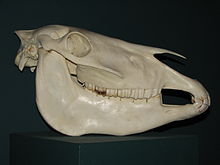
Skull of the Przewalski horse
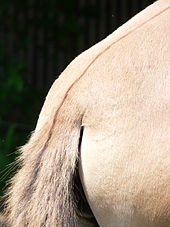
Upper rump of the tail of the Przewalski's horse with the characteristic short hairs and the eel line
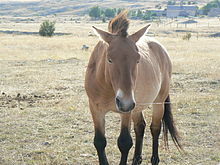
A short standing-mane is characteristic for the Przewalski horse

Przewalski's horse with reddish colored coat
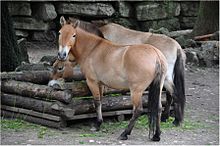
Przewalski horse with clearly visible stripes on shoulders and legs at Salzburg Zoo
Distribution and habitat
The Przewalski's horse once populated a larger part of the Eurasian steppe landscapes as the easternmost wild horse form. The exact distribution area in historical times is unknown. Towards the end of the 19th century, the animals probably occurred only in Dsungarei. Information on capture and sighting locations from this period can be assigned to a region that ranged from 85 to 95° E and 44 to 50° N. No reports of wild horse sightings were published between the years 1903 and 1947, when a Przewalski's horse was last captured. It was not until the 1950s and 1960s that sporadic sightings were reported again. The last observation on Chinese territory was in the late 1950s. In 1969, wild individuals were documented by an expedition organized by the Biological Institute of the Academy of Sciences of Mongolia, which is also the last observation to date. All sightings of this late period span a region from Bajtag-Bogdo in the west to Tachin-Shara-Nuru in the east. The observation area thus covers 93 to 94° E and 45 to 46° N.
The areas from which the last reports of the Przewalski's horse originate are wind-exposed high plateaus of the Gobi with altitudes around 1000 to 1400 m. The vegetation can locally be quite dense and then consists mainly of tall-growing saxaul (Haloxylon ammodendron). The vegetation can be locally quite dense and then consists mainly of tall-growing saxaul (Haloxylon ammodendron). In addition, the European Queller (Salicornia europaea), Artemisia incana, which is related to wormwood, the grass species Lasiagrostis splendens and Stipa orientalis as well as the herb species Tulipa uniflora and Rheum nanum occur. In other areas, however, there is only a thin plant cover of various salt herbs. Daytime temperatures vary up to 25 degrees, as even in summer the nights are very cold. January is the coldest month with average temperatures ranging from -15 to -18 °C. In the summer months, the air temperature can reach 40 °C. The little precipitation falls mainly in the summer months and rarely exceeds 400 mm per year. Mammals equally native to the Przewalski's horse habitat include the jiggetai (Mongolian half-ass), various antelope and gazelle species such as the saiga, Mongolian gazelle and Mongolian goiter gazelle, and the wolf.
It is currently unclear whether the areas of the most recent sightings are a preferred habitat of the Przewalski's horse, or whether they form a marginal refuge to which the animals were forced due to thousands of years of competition with the nomadic livestock breeders of Central and Northern Asia. One position held is that the Przewalski's horse was adapted to more arid landscapes because of its eastern distribution. This is opposed by the opinion that the animals, like other caballine horses, preferred rather moderately moist grassland areas. At least modern wild populations fare better in wetter landscapes that offer denser vegetation cover as well as closer water resources.
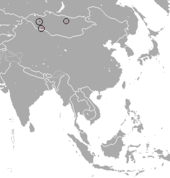
Present distribution since reintroduction
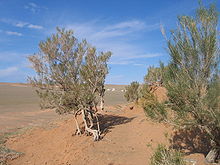
Saxaul is one of the guiding plants of the Przewalski's horse habitat
Questions and Answers
Q: What is Przewalski's horse?
A: Przewalski's horse is a rare and endangered subspecies of the wild horse, Equus ferus, which is native to the steppes of central Asia, especially Mongolia.
Q: What is the relationship between the domestic horse and Przewalski's horse?
A: The domestic horse and Przewalski's horse are close relatives that can cross-breed and produce fertile offspring.
Q: What is the current status of Przewalski's horse in the wild?
A: Przewalski's horse was once extinct in the wild, but reintroduction efforts have led to the establishment of several nature reserves and national parks.
Q: What is the world population of Przewalski's horses?
A: As of 2002, the world population of Przewalski's horses was about 1,000.
Q: What is the geographic range of Przewalski's horse?
A: Przewalski's horse is native to the steppes of central Asia, especially Mongolia.
Q: Why is Przewalski's horse important from a conservation standpoint?
A: Przewalski's horse is an endangered species that serves as an important focus of conservation efforts.
Q: What efforts have been made to increase the population of Przewalski's horses?
A: Reintroduction efforts, including the establishment of several nature reserves and national parks, have been implemented to increase the population of Przewalski's horses.
Search within the encyclopedia